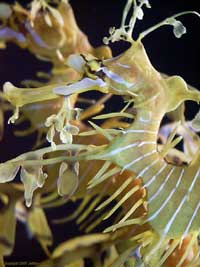Dragon leaves
 If there are no dragons that exist in this world, it may not be right. Just once seeing the Phycodurus eques many people will believe there is a dragon right away, only something that is not a fire-breathing dragon in myth is an animal that is much like a smaller sized dragon.
If there are no dragons that exist in this world, it may not be right. Just once seeing the Phycodurus eques many people will believe there is a dragon right away, only something that is not a fire-breathing dragon in myth is an animal that is much like a smaller sized dragon.
Phycodurus eques is one of the most beautiful fish and also has many mysteries on the Japanese level of the ocean world.
Looking at the dragon's leaves, it looks like eyes, it looks like a tree with strange leaves. Those leaves are the leathers, hanging all over the head, tail, and look just like real leaves.
Those leaves don't help the dragon move. In fact, the dragon leaf body also rarely seems to be moving. If you look closely, the leaf dragon moves to imitate the swinging motion of the kelp under the sea, only to have a close look to see the faint little fins that help them move.
It can be said in the world of animals, leaf dragons are one of the most evolved species in camouflage art. Wild fish are hard to tell if a leaf dragon is an animal, because it is too similar to a colorful tree. Throughout the dragon's life, the leaves just swam among the kelps of the three main species of Macrocystis, Ecklonia and Lessonia.
Because there are no swimming divisions like other fish, even though it is known as "dragon" , this animal is a very weak swimmer. However, their tails cannot be grasped (like seahorses), lifelong dragons must constantly move even if they do not swim far away.
The life of the leaf dragon is associated with the kelp forests under water , which also has good reason. With leaf-like camouflage, they are safe between leaves. But when separated from the plant world, they become more attractive than normal prey because of their fancy shapes and will quickly become good prey for many large fish.
In addition to its leafy shape, Phycodurus eques has a long , small muzzle , which is mainly used to suck prey into small mouths. The favorite food of leaf dragon is small invertebrates, living around in kelp forest.
 When defending as well as attacking, dragon leaves know to shrink, pointing out the thorns - thorns are the most important weapon of leaf dragon, however in nature few enemies use dragon leaves as a main food.
When defending as well as attacking, dragon leaves know to shrink, pointing out the thorns - thorns are the most important weapon of leaf dragon, however in nature few enemies use dragon leaves as a main food.
The way of reproduction of leaf dragon is no less strange. The dragon lays once a year, laying about 250 eggs at a time. Females send their eggs to an incubator on the male's tail. This set of incubators contains a porous section - each of which is used to hold an egg (fertilized eggs during the process of transferring eggs to males). Eggs are brought by male dragons with them until they hatch. After about 8 weeks, eggs hatch, but in nature only about 5% of the eggs are grown to adulthood (about 2 years old).
Leaf dragons often live at a depth of 5-35m , and are especially only found in temperate waters (year-round temperatures of 14-19 degrees C) along the southern coast of Australia in the sea kelp forest around Kangaroo. Island and Lancelim.
Normally dragon leaves grow to approximately 35cm in length, but sometimes they can reach a length of 45cm.
Leaf dragon is protected by Australian law. Without strict protection measures, many leaf dragons will be taken away by people, for sale to hobbyists and hobbyists. In addition, Chinese traditional medicine market is also very fond of this mysterious sea dragon.

- Successful breeding of dragon fruit with purple-pink gut
- Special technology leaves the leaves after a few hours
- Turn leaves into creativity 'no one expected
- 15 items of medicine from bamboo
- Private spaceship still arrives at ISS despite trouble
- Video: Komodo dragon re-feeds the raw chicken
- Beams of maple leaves fall extremely romantic and beautiful
- Why sawn wax leaves with holes?
- New purple dragon fruit varieties
- Simple cure with leaves
- Why are leaves green?
- The taboo when eating dragon fruit, everyone should know to avoid picking up disease in the body
 Surprised: Fish that live in the dark ocean still see colors
Surprised: Fish that live in the dark ocean still see colors Japan suddenly caught the creature that caused the earthquake in the legend
Japan suddenly caught the creature that caused the earthquake in the legend A series of gray whale carcasses washed ashore on California's coast
A series of gray whale carcasses washed ashore on California's coast Compare the size of shark species in the world
Compare the size of shark species in the world